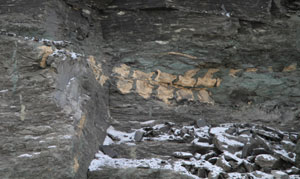
Cooperation between Syncrude and the Royal Tyrrell Museum has produced another spectacular fossil. On November 14 Maggy Horvath, a heavy equipment operator for Syncrude, uncovered the remains of a long-necked plesiosaur.
“I think it’s great that I’m part of this,” said Horvath. “It felt pretty good to call my son and let him know that I found a prehistoric fossil.”
Long-necked plesiosaurs, more accurately known as elasmosaurs, were a group of marine reptiles that lived from the late Triassic period, roughly 210 million years ago, to the end of the Cretaceous, 65 million years ago, when they went extinct.
The group is characterized by having a large body, four flippers, a small tail, long neck, and small head. They would have eaten a wide variety of marine life, including fish and cephalopods. The long neck would have helped them ambush and quickly strike at prey.
Horvath exposed a series of vertebrae and stopped digging in the immediate area. Horvath then told Syncrude’s geologist, who notified the Tyrrell Museum.
Last week the Tyrrell Museum dispatched a team of four to the site. Dr. Don Henderson, Curator of Dinosaurs, Jim McCabe, Preparation Lab Supervisor, and technicians Mark Mitchell and Joe Sanchez assessed the find.
The team searched the site thoroughly for more material, but as of yet have not found anything more. Working with Syncrude employees, the team has been able to isolate the large rock, estimated to weigh in excess of 6 tonnes, containing the fossil.
The latest find is the tenth to have been discovered on Syncrude leases. Other remains include an ichthyosaur, a dolphin-like marine reptile that oozed oil, and a short-necked plesiosaur skull. Both are on display at the Tyrrell Museum in the Alberta Unearthed exhibit.
The last elasmosaur from the same area was recovered ten years ago and was given the name Wapuskanectes. The specimen was only represented by the shoulder girdle and part of a front flipper.
“We are hoping that this is another specimen of the same kind of plesiosaur,” explained Dr. Don Brinkman, Director of Preservation and Research at the Tyrrell Museum. “The new specimen is particularly important because it looks to be nearly complete.”
The new specimen is roughly 110 million years old, about 2 millions years younger than the previous specimen.
“It may be something new, it may be the same thing, we’ll find out when we get prepared,” said Brinkman.
Preparation of the specimen may take some time. Weather conditions have prevented the Tyrrell team from bringing the specimen to the museum until spring. When conditions become favourable, museum crews will be able to stabilise the massive fossil and safety transport it to Drumheller.
















